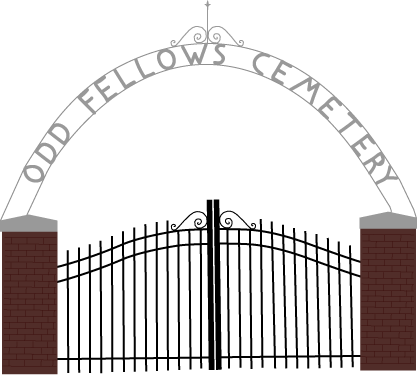Odd Fellows name Lexington cemetery
Odd Fellows name Lexington cemetery
Holmes County Herald, Volume 38, Number 26
June 27, 1996
It appears that Odd Fellows Cemetery in Lexington came about after the formation of the B. S. Tappen Odd Fellows Lodge No.22 that was chartered in Franklin on April 10, 1849.
The Odd Fellows organization was famous for beginning cemeteries.
On March 14, 1850, the B. S. Tappan Lodge No.22 bought a building on the square in the Town of Lexington from Hugh H. Fults and his wife Indiana E.
James M. McLean, Joseph N. Spencer and Abner V. Rowe are shown to be members of the Lodge in a deed dated November 1851.
The only problem is that we could not find the deed setting out the land for a cemetery. What we do have is several persons being buried at the site prior to 1850.
The oldest recorded in L. L. McNees' Cemetery Record, Holmes County, Mississippi is that of Robert J., son of L. and A. L. Ray, died June 8, 1843 at the age of 1 year, 5 mos. and 8 days. Another child was buried here after her death on Sept. 24, 1846. She was Mary Ann Dyson, age 1 year, 5 mos. and 4 days, the daughter of W. H. and Sarah A. Dyson. Walter Brooke Haynes, one of twin sons of James M. and Harriet A. Haynes, was also buried before 1850. He died on Oct. 4[6], 1849.
The Lexington cemetery grounds actually is comprised of two cemeteries in one area today.
Originally, there was one cemetery started by the Odd Fellows organization.
On June 6, 1902, J. H. and F. M. Watson deeded land adjacent to the Odd Fellows Cemetery to I. Flowers, Isadore Hyman, Sam Herrman, Morris Lewis, Abe Herrman, Sol Auerback, S. J. Fisher and H. A. Rosenthal as trustees of the Hebrew Cemetery.
The deed book in the Chancery Clerk's Office also has a map of the site and it is referred to on the map as the Jewish Cemetery. The land was divided into 51 lots.
Some of the more famous persons buried prior to 1900 include Otho W. Beall, born Oct. 15, 1794 in Franklin Co., Georgia. He died in Lexington on Jan. 12, 1866.
Mr. Beall had moved to Yazoo County in 1822, and when Holmes County was formed from Yazoo, he became Holmes County's first sheriff. He and Samuel Long both gave 30 acres of land that became the site of Lexington. Capt. William Nichols is probably the most widely renowned person buried at Odd Fellows.
A native of Bath, England, he died at Lexington on Dec. 12, 1853. (view tombstone photo from original article) Capt. Nichols, an eminent architect of Jackson was the architect for the Mississippi Capitol, the Governor's Mansion, the State prison, buildings on the Oxford campus of the University of Mississippi and many other private buildings, as well as the North Carolina Capitol at Raleigh, and of the Alabama Capitol.
He was the architect for the Holmes County Courthouse which was destroyed by fire in 1893, and the architect of Lexington Normal College, and the J. M. Dyer home, which later was the home of a school which was called "Terrystone."
Mayors of Lexington who are listed as being buried at Odd Fellows include: Abner V. Rowe, who was also Lexington's second postmaster serving from 1836-1838; William Lansdale Dyer, who served a number of years - 1882-83, 1886-87, 1906-1910 and 1912-18; Capt. John S. Hoskins; Capt. Cass Oltenburg; George W. Shackleford; J. W. Stone; Oscar F. Hosea; J. Simeon Stigler; H. S. Hooker; and H. S. Hooker, Jr.
A couple of interesting highlights of the Lexington cemetery include: a marker for Jim Eddie, son of J. G. and M. G. Hall. His epitaph reads, "killed by the falling of a slab in this yard."
His monument is also shared by his mother, Mary G. Hall, who had died just over 10 months prior to Jim Eddie. It appears he may have been visiting his mother's grave site when he was killed.
A grave that drew national media attention in 1983 is that of the "Lady in Red."
In 1969, work was taking place at Egypt Plantation at Cruger, when a backhoe accidentally unearthed a casket made of cast iron and glass.
The unknown lady inside had been sealed inside a clear liquid, probably alcohol, beneath half-inch glass. The remains were that of a perfectly preserved face and body of a young woman who is believed to have been dead since the late 1830s-early 1840s, according to her clothing.
She was clad in a red velvet brocade dress with a white lace collar. She had white gloves on her hands and stylish black boots on her feet.
J. T. "Tol" Thomas, III, and his sister, Steele Hardeman, who co-own the land on which the body was found, some time later had her remains moved from Egypt Plantation to Odd Fellows.
They ordered a simple granite tombstone with four lines cut into the granite: LADY IN RED FOUND ON EGYPT PLANTATION 1835-1969
View tombstone of William H. Foose.
View tombstone of Louisa Hoskins.
View tombstone of Torrey Family.
View tombstone of Haynes Twins.
SOURCE: "Odd Fellows name Lexington cemetery." Holmes County Herald (Lexington, MS), Volume 38, Number 26, 27 June 1996, http://hch.stparchive.com/Archive/HCH/HCH06271996P01.php
PO Box 1213
Lexington, MS 39095-1213
8:00 a.m. to 5:00 p.m.
Daylight Savings Time:
8:00 a.m. to 7:00 p.m.
Any unauthorized entry after closing is prohibited.
Copyright © 2026 Lexington Odd Fellows Cemetery, Inc.

